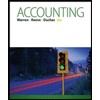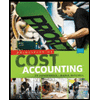
Concept explainers
1
Standard machine hours allowed for the actual number of units produced.
Introduction:
2
The total budgeted fixed overhead cost for the period.
Introduction: Overhead means the ongoing business expenses which are not directly incurred while producing product or service. Overhead is important while preparing budget but it is also used to determine the amount company must charge in order to incur profit.
3
The fixed portion of predetermined overhead rate.
Introduction: Overhead means the ongoing business expenses which are not directly incurred while producing product or service. Overhead is important while preparing budget but it is also used to determine the amount company must charge in order to incur profit.
4
The fixed overhead volume variances.
Introduction: Overhead means the ongoing business expenses which are not directly incurred while producing product or service. Overhead is important while preparing budget but it is also used to determine the amount company must charge in order to incur profit.
Want to see the full answer?
Check out a sample textbook solution
Chapter 10A Solutions
MANAGERIAL ACCOUNTING FOR MANAGERS
 Managerial Accounting: The Cornerstone of Busines...AccountingISBN:9781337115773Author:Maryanne M. Mowen, Don R. Hansen, Dan L. HeitgerPublisher:Cengage LearningPrinciples of Accounting Volume 2AccountingISBN:9781947172609Author:OpenStaxPublisher:OpenStax College
Managerial Accounting: The Cornerstone of Busines...AccountingISBN:9781337115773Author:Maryanne M. Mowen, Don R. Hansen, Dan L. HeitgerPublisher:Cengage LearningPrinciples of Accounting Volume 2AccountingISBN:9781947172609Author:OpenStaxPublisher:OpenStax College Accounting (Text Only)AccountingISBN:9781285743615Author:Carl Warren, James M. Reeve, Jonathan DuchacPublisher:Cengage Learning
Accounting (Text Only)AccountingISBN:9781285743615Author:Carl Warren, James M. Reeve, Jonathan DuchacPublisher:Cengage Learning Principles of Cost AccountingAccountingISBN:9781305087408Author:Edward J. Vanderbeck, Maria R. MitchellPublisher:Cengage Learning
Principles of Cost AccountingAccountingISBN:9781305087408Author:Edward J. Vanderbeck, Maria R. MitchellPublisher:Cengage Learning Managerial AccountingAccountingISBN:9781337912020Author:Carl Warren, Ph.d. Cma William B. TaylerPublisher:South-Western College Pub
Managerial AccountingAccountingISBN:9781337912020Author:Carl Warren, Ph.d. Cma William B. TaylerPublisher:South-Western College Pub Financial And Managerial AccountingAccountingISBN:9781337902663Author:WARREN, Carl S.Publisher:Cengage Learning,
Financial And Managerial AccountingAccountingISBN:9781337902663Author:WARREN, Carl S.Publisher:Cengage Learning,





